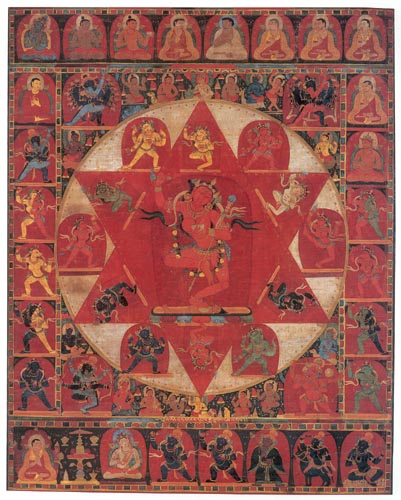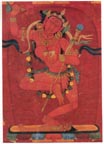| 20. Vajravarahi Mandala
|

20.
Vajravarahi Mandala
Central Tibet (Taklung monastery), ca.
1200
Distemper on cloth
70 x 56 cm (271/2x 22 in.)
Private collection
click on image below for 20: Detail full screen view
|

20: Detail
|
|
This work depicts the mandala of Vajravarahi, a goddess often invoked by monks newly initiated into Tantric
meditation practices. At the center of the mandala is a dancing figure of Vajravarahi
(Diamond-like Sow). The
goddess is associated with triumph over ignorance (symbolized by the sow), and this, her characteristic
attribute, appears just above her right ear. The almost-naked figure imparts a sense of wild abandonment: her
long dark hair cascades down her back, her tiara is fixed with skulls, and a pendulous necklace of severed heads falls over her shoulders and onto her thighs. In her right
hand she holds the chopper (kartrika), in her left, the skull cup (kapala); tucked in the crook of her left arm is a
ceremonial staff (khatvanga). She tramples an inert body positioned atop an open lotus.
Early Tibetan translations of Sanskrit texts, such as the Sadhanamala (Garland of Means for [Spiritual]
Attainment), the Nishpannayogavali (Garland of Perfection Yogas), and the
Hevajra Tantra, describe Vajravarahi's mandala as unfolding within the heart of a practitioner. These texts describe some (although not all)
of the divinities represented here in her assembly and the six-pointed star within which she
appears. Other early Tibetan paintings also portray Vajravarahi; their
assemblies differ, suggesting
numerous sources for her iconography in twelfth-and thirteenth-century Tibet.1
The Sadhanamala describes
the six-pointed star as the union of male (the upward-pointing triangle) and female (the downward-pointing
triangle) energies.2
The bottom four figures in each of the painting's side registers are described in literary accounts as deities from
the mahasukha (Great Bliss) realm, which encloses Vajravarahi's mandala and is said to be located at the
periphery of the cosmos.3 The diagram at the left below outlines the names of these deities and the directions of
the mandala over which each presides:
1. Kakasya, east (blue and head of a crow)
8. Ulukasya, north (green and head of a hawk)
6. Svanasya, west (red and head of a dog)
3. Sukarasya, south (yellow and head of a sow)
Deities at the intersections of the cardinal directions all possess human heads and are
bicolored:
2. Yamadahi, southeast (blue and yellow)
4. Yamadhuti, southwest (yellow and red)
5. Yamadamstri, northwest (red and green)
7. Yamamathami, northeast (green and blue)
The painting's several inscriptions are rich in information and shed light on its early history. The gold inscription
centered just above the lower register states that the painting is "the personal meditational image
(thugs dam)
of Onpo Lama Rinpoche," who briefly acted as fourth abbot of Taklung monastery between 1272 and 1273
.4 The
reference to this painting as Onpo's thugs dam suggests
that Onpo used the painting in Tantric visualization practices, specifically the first of three
meditational stages—known as kyerim (skyes rim), the development, or
generation, stage — whereby the appearance of the deity and his or her entourage is memorized until it can be
reconstructed vividly within the mind of the practitioner.
An inscription on the back of the painting was composed by Onpo himself.
It reads: "May the incomparable Holy Lama Prajnaguru [the Sanskrit equivalent of the initiation name given to Onpo's teacher, Sangye Yarjon] and I–Kirtishri Rashmibhadra [the Sanskrit
equivalent of Onpo's birth name, Drakpapel Oser Sangpo] have inseparable power to attain the oral teachings, to
purify our mistaken minds, and to guide beings to [spiritual] liberation."5 These inscriptions were probably composed by Onpo sometime between 1264 (when, at age thirteen, he met his teacher Sangye Yarjon) and 1273, the year after Sangye Yarjon's death, when Onpo left Taklung for eastern Tibet.
However, analysis of the painting's consecratory inscriptions and the top register of spiritual teachers suggests the likelihood that the painting itself was executed considerably earlier and that the other inscriptions were later additions to the work, which possibly dates to the time of Tashipel and which Onpo
inherited from his teacher. The top register includes the usual Taklung masters (see cat. no. 13) through
Tashipel, with one further hierarch in the right-side register—logically, his successor, Kuyelwa (1191-1236).
The consecratory inscriptions—written when the painting was made (see page
18)—make no reference to a
spiritual lineage. However, two further inscriptions along the top of the painting's verso state that the painting was
consecrated by successive Taklung abbots. Barely legible, these inscriptions offer crucial information about the painting's date and its early history. The inscriptions, one
in gold and one in red Tibetan (uchen) script, appear to be in the same hand and are identical in content except for
three important syllables. The gold inscription, written first
(evident for reasons outlined below), may be translated: "Each of the 108 consecrations of the XXX [a numeral,
possibly bzhi'i, "four"] masters and disciples, from Chöje Rinpoche (chos rje rin po che) through to Lama Rinpo [...] dwells [here]." The red
uchen inscription appears directly
above the gold and differs from it only by the inclusion of three syllables missing from the last name mentioned
above; the relevant passage reads: "beginning with
Chöje Rinpoche through to Lama Rinpoche Onpo.''6 The scribe
must have recognized his error after misspelling Onpo Lama Rinpoche's name and correctly rewrote the
inscription in red above the earlier gold inscription. Chöje Rinpoche almost certainly refers to Taklung founder
Tashipel, for this epithet is used to refer to him in early
Taklung histories. Moreover, another Taklung painting bears a virtually identical inscription, stating
"[this
painting], passed from teacher to disciple beginning with Chöje Rinpoche through to Onpo Lama Rinpoche, was
immeasurably consecrated by these four."7 In this case, there can be no doubt that
Chöje Rinpoche refers to
Tashipel and the "four" refers to Taklung's first four abbots. If Tashipel did confer his 108 blessings on this
painting (as this interpretation of the inscription implies), it must date from before 1210, the year of his
death.8 Tibetans
placed great value on objects belonging to saints, believing that such objects could assume the sanctity of
their previous owner or owners. Many works of art, such as this one, were treasured as relics and passed from
master to disciple. JCS
1. See
Béguin 19go, pp. 172-73. [back]
2. Mallmann 1969, p. 22. [back]
3. Ibid., P. 31 n. 3. [back]
4. bla ma rin po che dbon po dpal gyi thugs dam lags//. Thugs dam is
the honorific term for yi dam, itself a translation of the Sanskrit word
ishtadevata, "chosen deity." [back]
5. mtshungs med bla ma dam pa pradznya 'ghu ru dang// bdag
'ghit ti shri ra smri bha tra 'bral med ci gsung bka'bsgrub cing// rang sems 'khrul pa dag pa dang// `gro'ba'i 'dren pa nus par
shog//. This inscription is written in gold uchen script. [back]
6. chos rje rin po che nas bla ma rin po che dbon po dpal yan chod
yab sras [XXXI rab gnas brgya rtsa brgyad re bzhugs/. [back]
7. chos rje rin po che nas bla ma rin po che dbon po dpal yan chod
yab sras bzhi'i rab gnas dpag du med pa bzhugs/. This inscription appears on a painting recently identified as the Mahashri
Heruka Mandala, now in the Michael J. and Beata McCormick collection, published in New York 1997, PP. 78-79.
[back]
8. If this interpretation is correct, then we have evidence of a
living master-in this instance, Tashipel--depicted in a painting's top register. To date, it seemed that a painting's top
register was reserved for deceased members of the commissioning community's spiritual lineage, but this mav not have always
been the case. [back]
|

